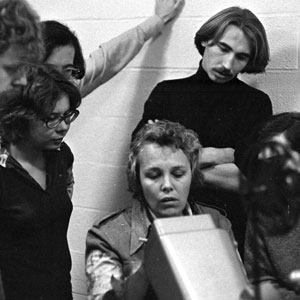Men in drag? Underground volunteering? The arrival of women on campus changed the way men participated in clubs and then changed the clubs themselves. Learn more from our prehistory documents, images, and interviews.

Although extra-curricular activities at Bowdoin College long precede coeducation, the arrival of female students on campus significantly changed the ways students participated in and organized activities outside of the classroom. In theater, for example, Brunswick women and faculty wives participated in Masque and Gown productions as early as 1927, but it wasn’t until the early 1970’s that women could take an official role in the production process.
Curriculum changes that resulted from coeducation also, at times, ushered in new student clubs. The Film Society was founded in 1974 by Barbara Kaster, one of the few female professors on campus at the time. Professor Kaster made film production mandatory in her film history course so that male and female students had experiential as well as intellectual experiences with film. The Dance program similarly grew out of Professor June Vail’s dance classes, which initially were offered as non-credit courses.
Women claimed and created spaces for themselves. The Voluntary Services Program organized student volunteer efforts and made volunteering accessible to all students, meeting the needs early on of female exchange students who were on campus for a limited time. The Bowdoin Women’s Association created a space for women to come together and articulate concerns about student life.
The ways in which women changed the college are multiple. Female faculty as well as female students played a critical role in challenging the traditions of this all-male college. Take a look at our related archival documents, photos, and interviews, and see the impact of coeducation outside of the classroom.